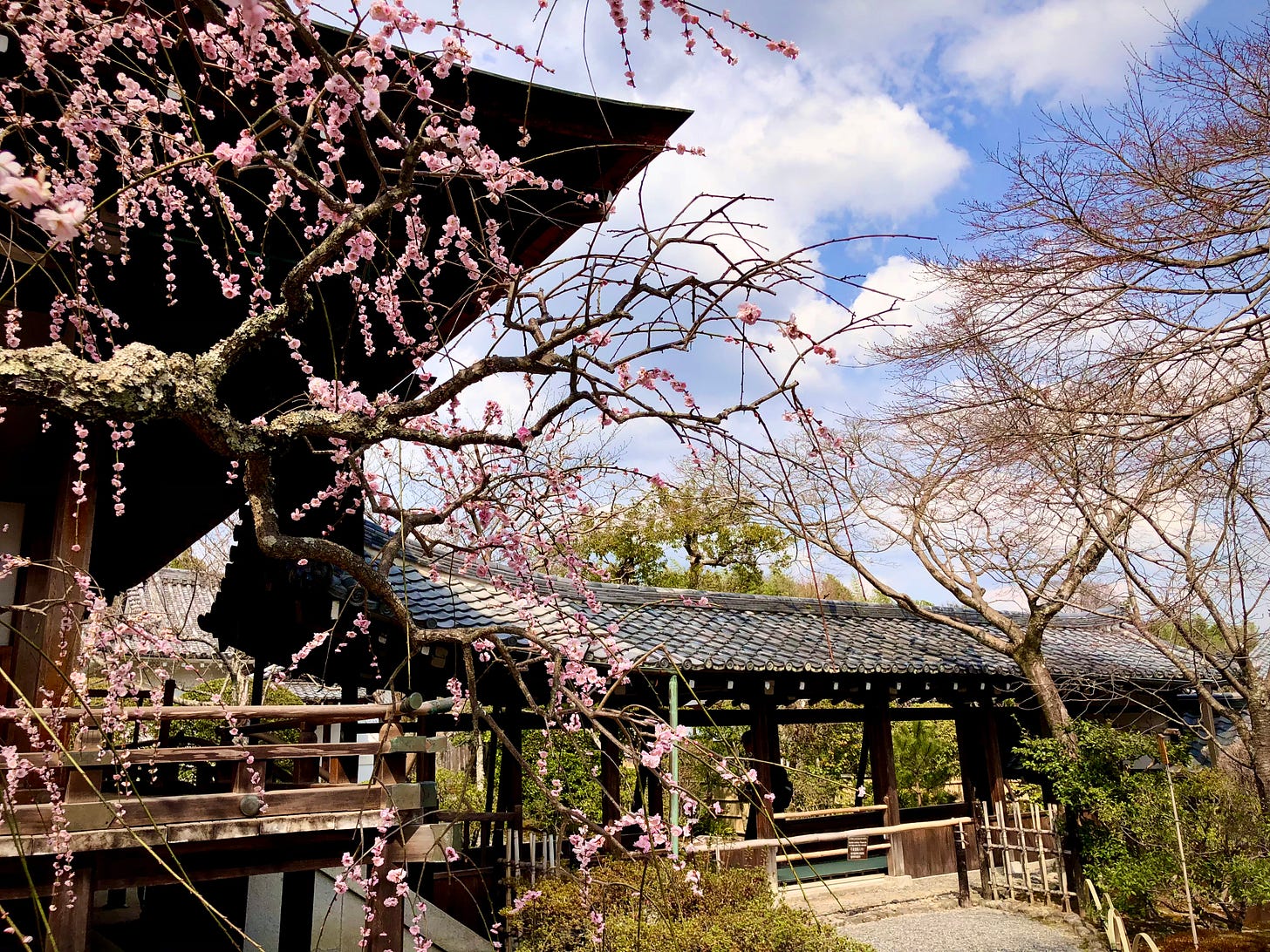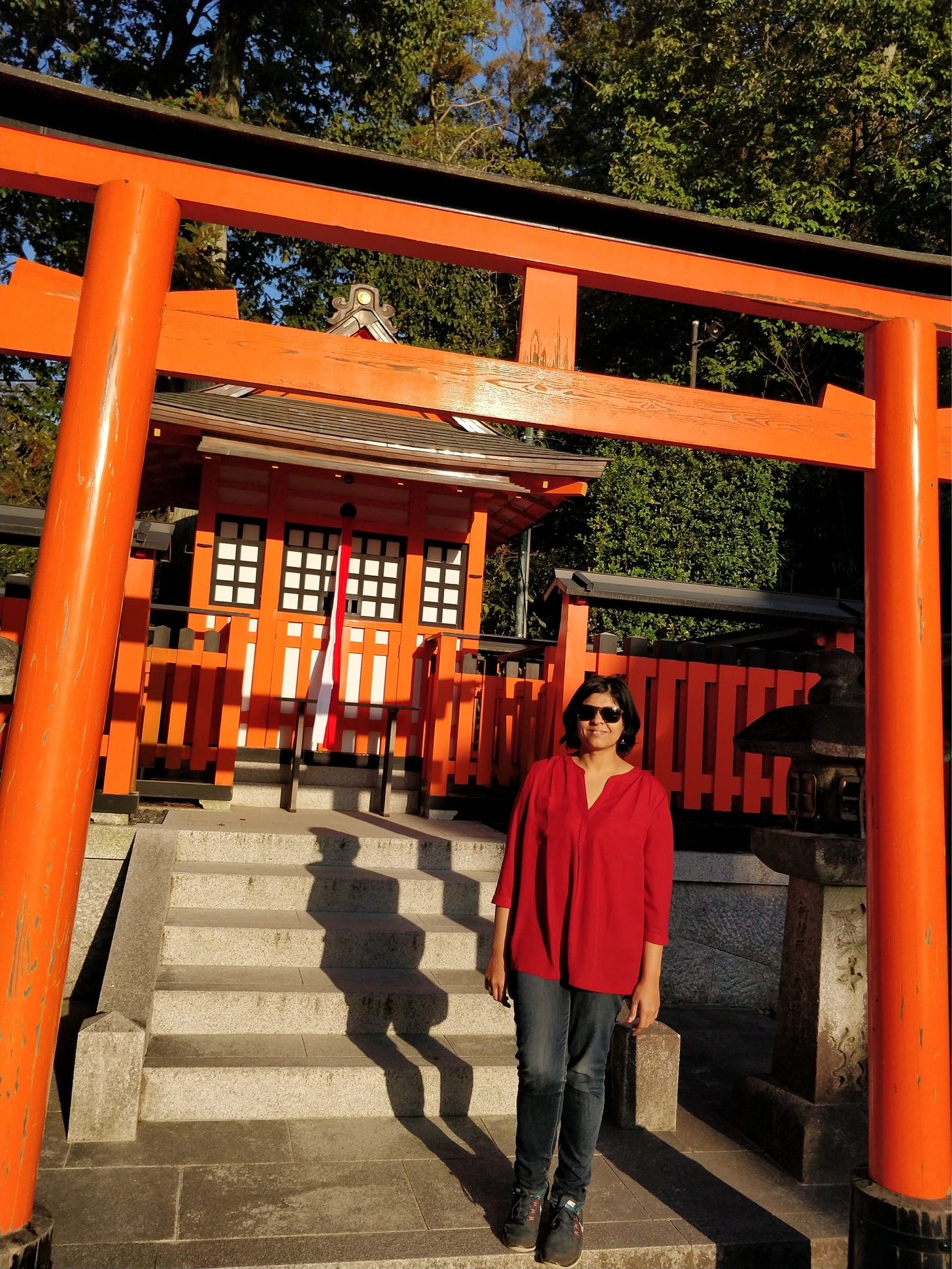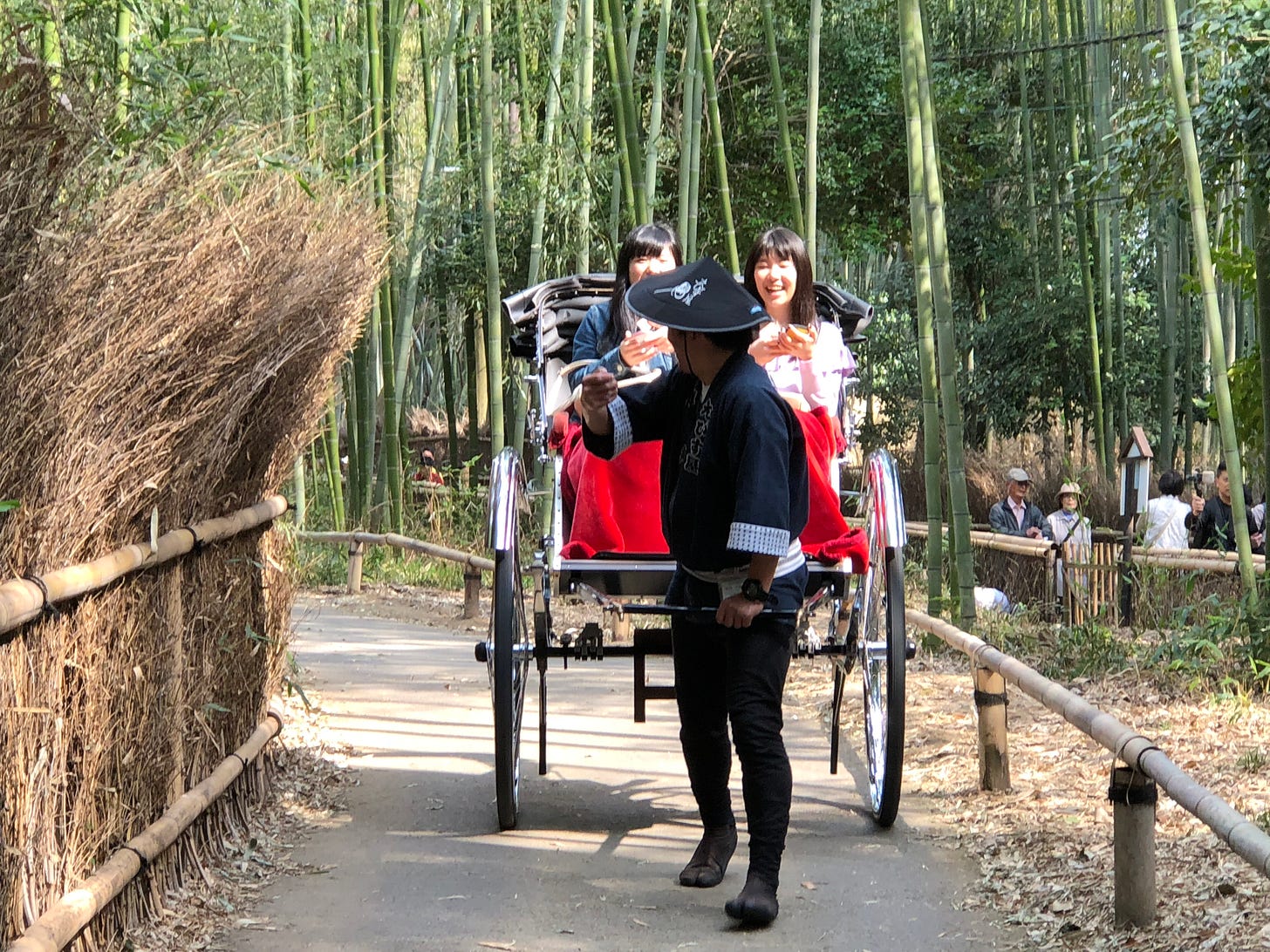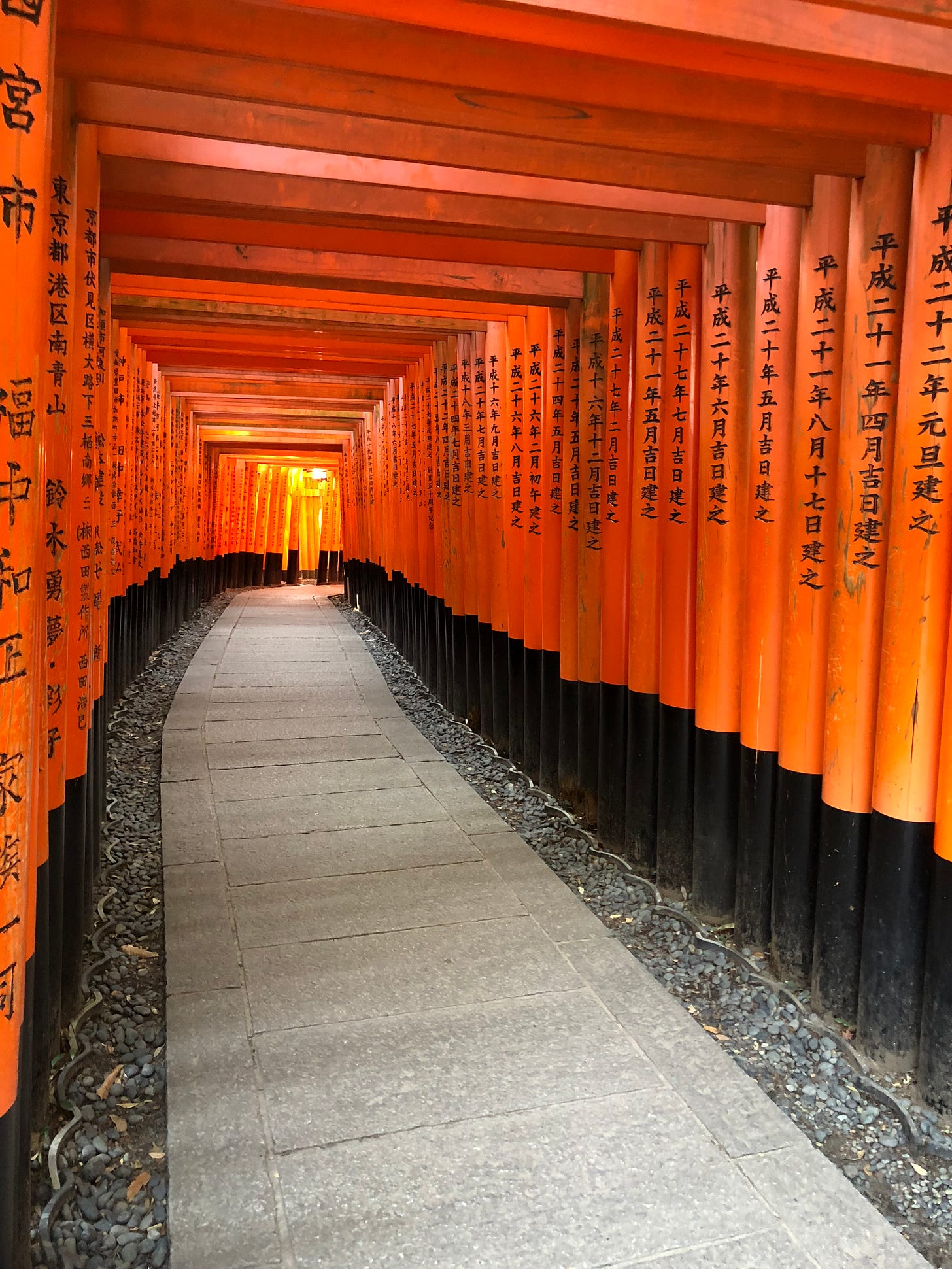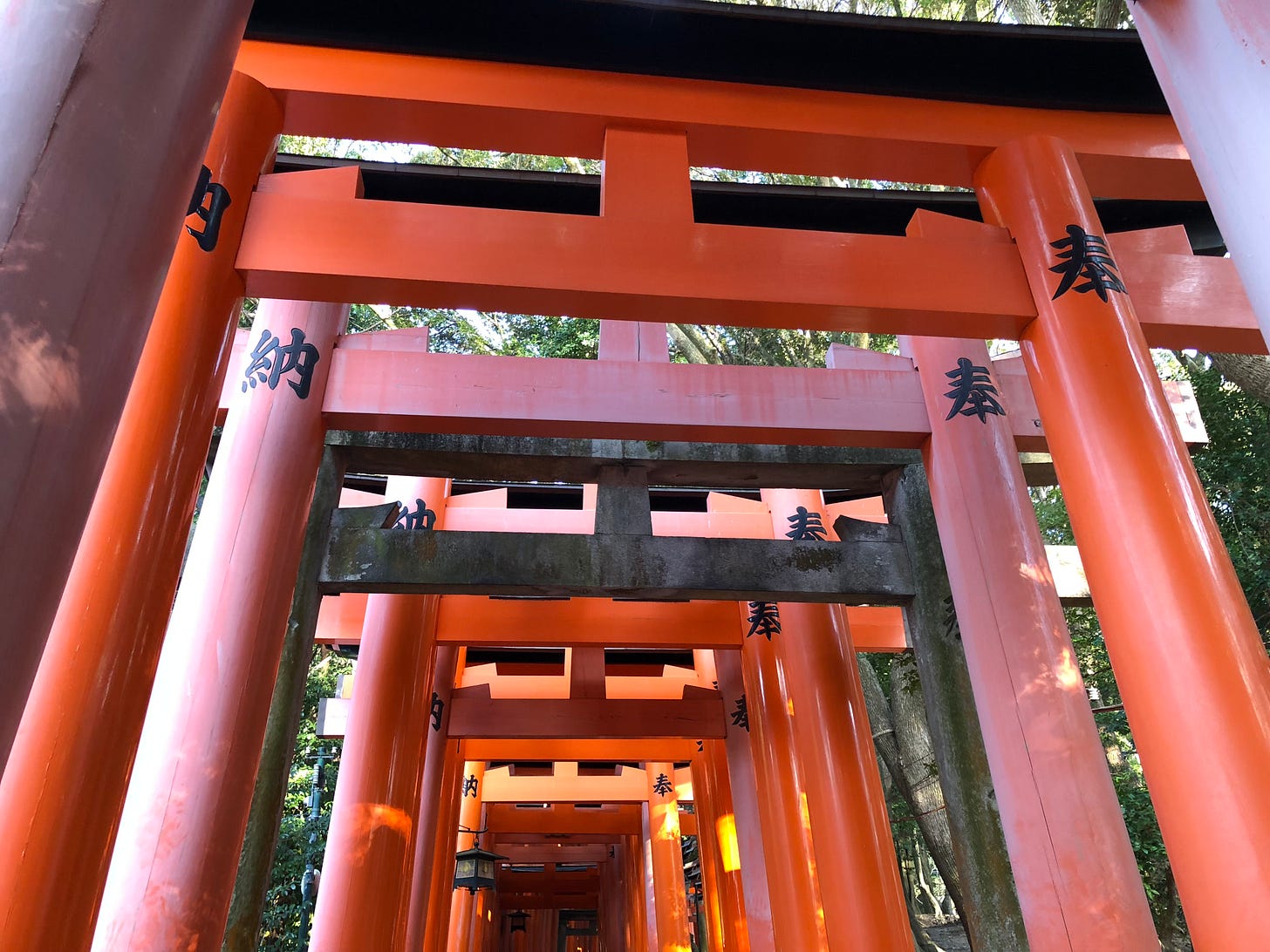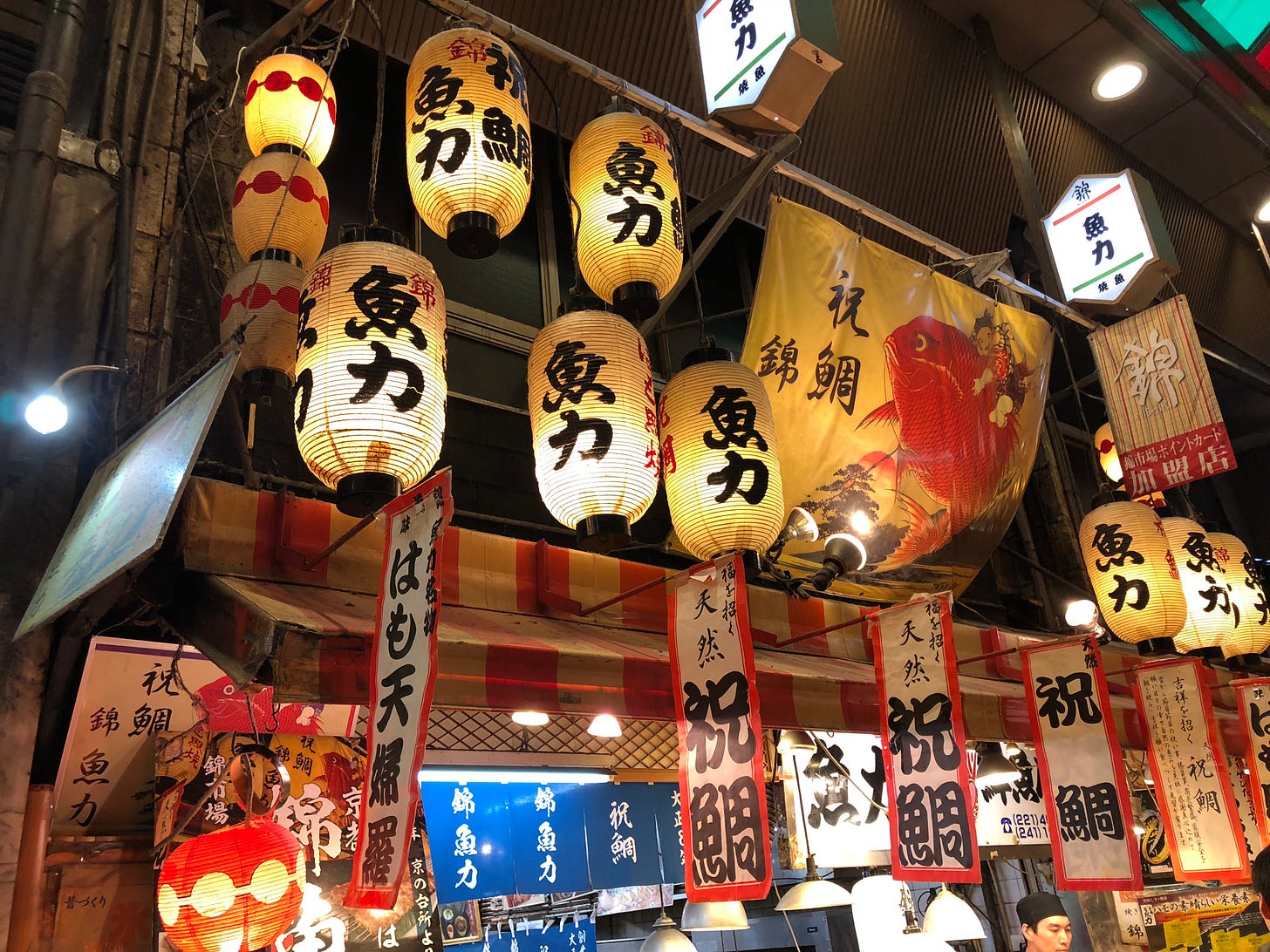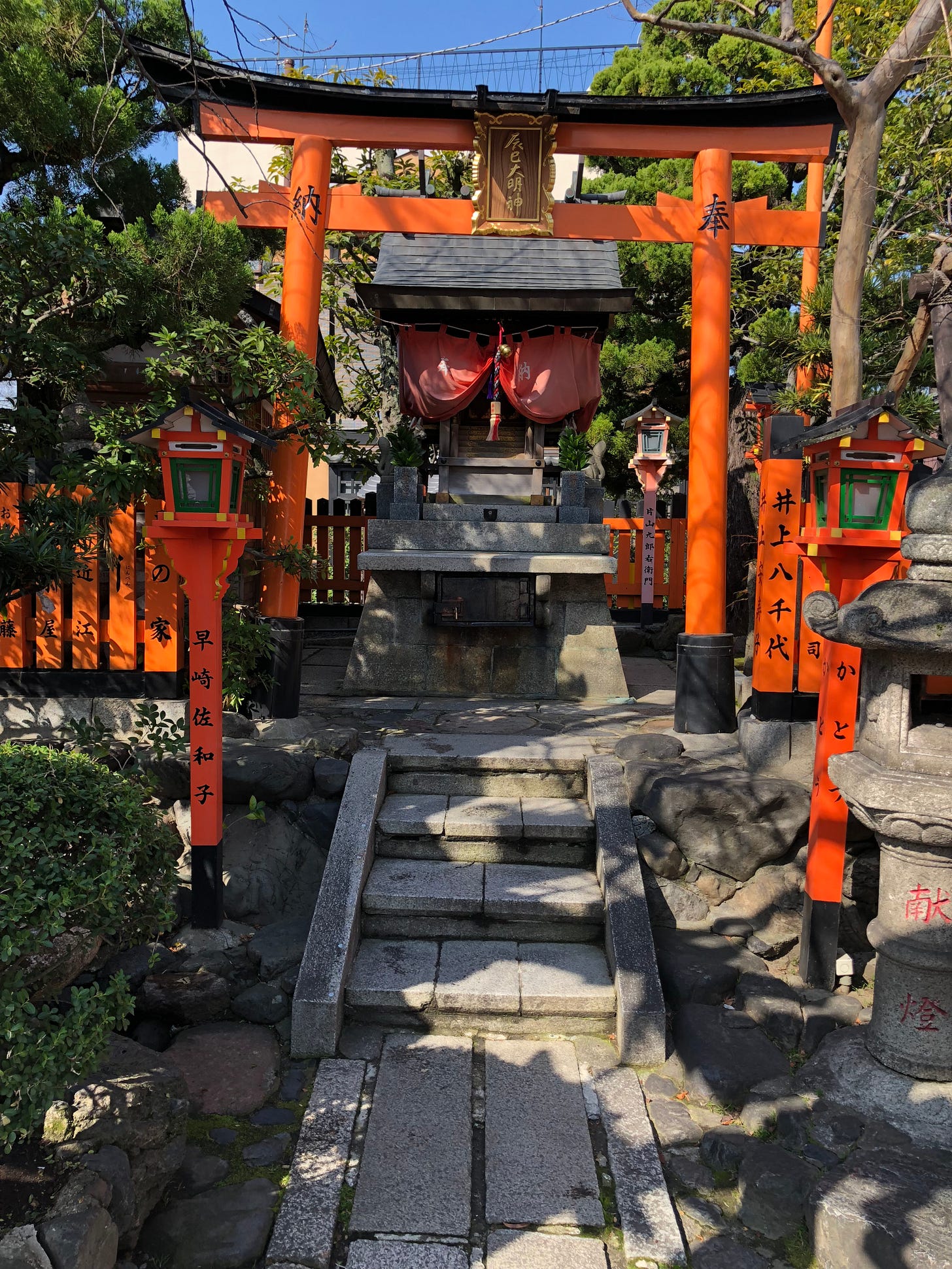Journeys and Jottings
Issue 73 - Japan and Japanese, Best Things to do in Kyoto, Yutori- Word of the Day
Word of the Day -Yutori ( Japanese). Meaning “room” or “spaciousness”, it transcends the concept of physical space and dimensions into a more mindful concept. Yutori is a call to slow down, to breathe, to pause, and to create more room in your life, in relationships, in your work, and even in your day-to-day life. It signifies a sense of space in your life, more mental room allowing for moments of stillness, relaxation. We don’t have to fill every minute and be productive all the time as we strive towards work-life balance. Let your day be filled with white spaces, let your mind wander, breathe with intention, let go of pressure, have more mindspace and be more present and mindful.
I have always been a fan of everything Japan and Japanese - the place, the people, the language, their way of life. I even attempted to learn the language. Most of the words in Japanese are beyond just lingo, but are concepts, principles, a manual for life, and they hit home all the time. I have been to Japan once on a very short trip, but I hope to go there again someday. I am sharing an article I wrote on Kyoto, my favourite city for Travel and Leisure Asia.
Top ten best things to do in Kyoto
A sense of timelessness permeates the air as the Shinkansen Hikari Bullet Train comes to a grinding halt, marking the end of a whirlwind journey. As you wade through the milling crowds and step out into the ancient capital of Japan, you realise why Kyoto is hailed as the poster child of ”Zen”. The land of 2000 temples with a staggering 17 World Heritage Sites is caught in a time warp, steeped in lost traditions and surrounded by sublime gardens, atmospheric lantern-lit lanes, wooden tea houses and postcard vistas. Surrounded by hills, the city of geishas and maikos is enveloped in a state of stillness, and sometimes the only sound you can hear in one of the tranquil nooks is the murmuring of a brook in a lush garden.
But there is more to Kyoto than golden temples and vermilion shrines. The Imperial City, with its palaces and castles, take you back to the era when Kyoto was home to emperors. The bustling markets and the varied museums vie with bamboo groves and verdant forests for your attention. Traditional tea ceremonies and rituals add to the list of fascinating experiences. Kyoto has something in it for every traveller, be it for those seeking spiritual solace or thrills and adventures. There are fun and free things to do for travellers of all ages, and it is magical in every season. If you are a first-time visitor to the Japanese cultural capital, then here are the ten best things to do in Kyoto, which will inspire you to plan your next trip.
Best time to visit Kyoto
Kyoto beckons travellers throughout the year as every season has its charm. Spring and autumn are however the best times to visit Kyoto, with cherry blossoms and fall foliage being the main attractions. March to May and October to mid-December are the high tourist seasons when the city explodes into colour and with people. Summer brings in a lot of tourists, too, and the rains add a dash of green to the gardens. June to September is also the time for several festivals and cultural events, including the Gion Matsuri pageant. Winter wonderland, though considered the low season, is no less beautiful as the temples are wrapped in snow and the pearly white landscapes add to the magic.
How to reach Kyoto?
The best way to reach Kyoto from Tokyo is by the Shinkansen or the bullet train. There are three of them that runs on the Tokaido Shinkansen line- Nozomi, Hikari, and Kodama. It takes a little more than a couple of hours and it is better to buy a ticket with a reserved seat, especially during peak time. If you have purchased a JR ( Japan Rail ) pass, you can travel for free on the Shinkansen Hikari Bullet Train from Tokyo to Kyoto.
Watch a traditional artist at work - Best free thing to do in Kyoto
Head to the Kyoto Museum of Crafts and Design to see displays of century-old arts and crafts, from paper lanterns to bamboo flutes to different types of fans. Over 70 artists and craftsmen, and women conduct live demonstrations and workshops as well. Lose yourself in the flower arrangements, learn more about traditional textiles, and admire baskets, woodwork and metalwork. You can even learn a professional skill or observe artists at work here. Entry to the museum is free, and it is located very close to the Okazaki Museum district, where you can also see the Kyoto Municipal Museum of Art and the Museum of Modern Art. You can also visit the Heian-Jingu Shrine, which you cannot miss with its massive vermilion torii or gate
Test your love fortune - Best Fun thing to do in Kyoto
Quirky and quaint, some of the traditions here are very unique and endearing, like testing your love fortune around the Koiuranai-no-ishi or the love stones.. Kyoto’s charm has both locals and tourists beelining to the Jishu-Jinja Shrine located behind the Kiyomizu-dera temple to seek their luck at matchmaking and romance.
The Cupid of Japan is Okuninushi no Mikoto, and he is known to be gentle and sympathetic and will help you find love. And all that you need to do is to walk with your eyes closed around a pair of love stones that are set about ten metres apart from each other. And lo, you will find love around the corner if you succeed.
If you do take someone’s help in navigating your way, you might still be successful in romance, but you are going to need some divine help. Head to the waterfall, which is located just below the main hall of the shrine. The spring waters flow into three different streams, and you need to drink a cup of water from the one that is marked Love. And your romantic life will be in bliss. Don’t forget to buy the charms as well to improve your relationships.
Seek zen in the iconic temples - Best cultural things to do in Kyoto
With over a century of history as the Imperial Capital, Kyoto is a time capsule, and it is difficult to choose just one temple. However, you must visit the two iconic ones - Kinkaku-ji, the dazzling Golden Pavilion and the Ginkaku-ji, the demure Silver Pavilion. Start your day early to avoid the crowd at Kinkaku-ji, and you will find yourself mesmerised by the reflection of the golden tiered temple in the lake, set amidst a canopy of pine trees. Ginkaku-ji is known for its beautiful gardens, and don’t miss the trail behind the temple along the moss garden with bridges and islets that showcase some of the beautiful views.
However, if you are feeling a bit “ templed out” with the bustling crowd, then we would recommend a visit to the walled Daitoku-ji temple complex, an oasis of calm, dotted with 22 shrines set amidst spectacular rock gardens and tree canopies. While only four temples are open regularly, take time out to meditate and lose yourself in the verdant greenery. Each garden is symbolic, and the whirling and wave patterns, the rocks and ripples and the circles and pinnacles represent different levels of consciousness as they initiate you into Zen.
Join the ranks of the elite Ninja - Best things to do in Kyoto with family and kids
Step into the historic past and the shoes of a gallant samurai and an elusive ninja at the Samurai and Ninja Museum. The interactive and experiential museum is a perfect adventure for families as you can try your hand at Samurai swordsmanship, Don the armour of a samurai with the traditional hakama and and pick any of the replica swords and learn the ways of the ancient Japanese katana straight from the masters. You can also join the ranks of the Ninja and train to become a mysterious spy. Kids can participate in fun competitions like throwing Ninja stars. The museum also has original weapons, costumes and artefacts on display, and the guided tours will give you a peek into the legendary stories around the Samurai and Ninjas. It is better to book tickets in advance or online during the peak season.
Get charmed by a romantic train journey - Best things to do in Kyoto for couples
Nothing spells good old-fashioned romance like a charming train journey that chugs and puffs along the mountains and forests. Get on board the Sagano Romantic Train (Sagano Torokko) that takes you along the Hozugawa River between Arashiyama and Kameoka. The train meanders slowly along the 7 km, 25-minute journey, where you can see some of the most breathtaking views that change according to the season, from cherry blossoms in spring to maple leaves in autumn. Buy your tickets at the Saga - Arashiyama station and opt for the open car, where you can enjoy the scenic views of the ravine. Don’t forget to buy a combined ticket for the Hozugawa River Cruise, which you can enjoy on the way back
Lose yourself in the magical Arashiyama Bamboo Grove - Best things to do in Kyoto for Nature Lovers
Mystical and magical, the towering stalks of the Arashiyama Bamboo Grove draw droves of outdoor enthusiasts to the neighbourhood of Arashiyama ( Storm Mountain) ,located on the outskirts of Kyoto. It feels a bit ethereal as the sunlight filters through the dense canopy in this instagrammable spot as tourists head on a rickshaw ride along the bamboo alley.
Be here early in the morning to avoid the trove of tourists and head on a walking trail. The groves stretch for about 500 metres, and you can start at the picturesque medieval Tenryu-ji Temple with its enchanted garden. The bamboo groves then lead you to the Okochi Sanso villa owned by actor Denjiro Okochi. Follow the trail and go to the serene Kameyama-Koen Park, and then walk downstream along the Katsura-Gawa River. Don’t miss the photo opportunity at the Togetsukyo bridge.
While the entire walking trail takes a little more than an hour, you can stop by and explore more sights along the way. Some recommendations include the Gio-ji temple, Jojakko-ji shrine with mossy knolls and the Nison-in with maple arcade, the Rakushisha Poet’s Hut and the Katsura Imperial Villa among several others.
Hike to the summit of Fushimi Inari Taisha - Best thing to do in Kyoto for adventure/thrill seekers
A colonnade of eye popping vermillion gates or torii spread across a wooded mountain, surrounded by shrines and sculptures of foxes make Fushimi Inari Taisha one of the most spectacular shrines in Kyoto. And if you are a mood for adventure, then you must explore the shrine by foot. The hike to the summit of the Mt Inari San at 233 metre may seem easy but the distance of about 5 km can take over three hours or more.
Start at the Fushimi Inari Station on the Keihan line, or if you have a JR pass, at the Inari Station. As you reach the town, look for the first torii, which will lead you towards the temple precincts. Be prepared to climb steps along the way, crossing a few more gates until you reach a shrine called Higashimaru-jinja, which will then lead you to the main hall. You can buy amulets and even check your fortune. Continue your trail to the inner shrine by walking along a tunnel of vermilion gates called “Senbon-no-torii” (one thousand torii).
If this is not mesmerising enough, then head to the inner shrine where you see two stone lanterns called Omokaru Stones. If you make a wish and you can lift the rock easily, then your wish is likely to be fulfilled, but if you find it heavy, then you will have to deal with hardships. You can continue the trail to the summit by walking towards the upper shrine through more gates. Take a break at the tea houses, enjoy views over Kyoto and continue your summit uphill, crossing more shrines.
Fushimi Inari is the god of agriculture and commerce, and the fox is the messenger who is often showcased as holding the key to the granary. You can visit the shrine anytime as it’s always open and free.
Try traditional cuisine at Pontocho Alley - Best things to do in Kyoto at night
Enjoy the magical glow of Kyoto at night with the illuminated temples and shrines. Visit the Geisha district of Gion for a night tour and then head to the adjacent Portocho Alley for some authentic Japanese cuisine. Lit by red lanterns, the cobblestoned alley lends an old world charm but is bustling with exclusive bars and premium restaurants where you might catch a glimpse of a maiko or even a geisha.
Tea houses jostle for space with traditional restaurants and sake bars. Head east towards the Kamogawa River, where terrace seats are set up during summer, overlooking the waters. You may need reservations for the fine dining options, but you can walk into any of the local eateries and bars.
Enjoy your evening with sake and try the local yakiniku and yakitori - grilled meat and skewered chicken for starters. Beef cutlet with different sauces is another speciality from the casual dining restaurants here. Ukiyo Pontocho serves the famed handmade soba (buckwheat) noodles, while you can enjoy a full-course traditional Kaiseki dinner overlooking the river at Nagame Pontocho Hana with some locally brewed sake. If you are still hungry, then try the Okonomiyaki, a Japanese savoury pancake at Yasubei Pontocho
Celebrate Gion Matsuri with its colourful pageants - Best things to do in Kyoto in summer
Step into the world of geishas and maikos in Gion, the entertainment district of Kyoto, located around the Yasaka Shrine and Kamogawa River. You can experience the quintessential Japanese atmosphere here in the charming streetscapes dotted with traditional wooden houses called machiya and tea houses called machiya and the occasional chance of sighting a maiko or even a geisha makes it even more special.
While Gion can be visited anytime during the year, what makes it special during summer is the annual Gion Matsuri, the pageant festival at the Yasaka shrine celebrated in July. Plan your trip to experience the grand procession with vibrant floats called Yamaboko Junko, which is held on July 17. It is followed by another smaller pageant on July 24. The festival is, however, celebrated on the other banks of the Kamo River and has had an uninterrupted history since the 9th century, where it began as an appeasement to the Gods to protect them from pandemics and epidemics.
Soak in the warmth of an onsen - Best thing to do in Kyoto in winter
With snow-laced mountains and temples wrapped in a mystical wonderland, winters create picture-perfect postcards in Kyoto. But the best way to appreciate the winters is to find the closest onsen or hot spring baths, or immerse yourself in a sento or public bath which uses hot spring waters. While most of the onsens are slightly further away from Kyoto Downtown, you can head to the old Funaoka Onsen, which is a Sento. They have a variety of baths - a wooden bath, herbal bath, giant bath and even an extra hot bath and an electric bath besides a sauna. If you are looking for an onsen, then head to Tenzan-no-yu onsen near Arashiyama, where there are different spacious baths and saunas too, and the spring water has been drilled 1200 metres below the city.
Do you have any more recommendations for Kyoto?
Support my work, please
I do hope that you enjoyed reading this issue. Looking forward to your feedback as always. As mentioned earlier, if you would like to collaborate, do drop in a message here.
And if you did like reading this issue, would appreciate it if you could upgrade to being a paid subscriber. It costs less than $1 a month and around $10 for the whole year. It would go a long way in supporting me and my work.
We are going to keep the flow of conversations going and I would appreciate it if you would share my newsletter with your friends and family.
See you soon! You can also read my travel stories on my blog and follow me on my social media.
Blog - www.lakshmisharath.com
Twitter - www.twitter.com/lakshmisharath
Facebook - www.facebook.com/travelwithlakshmi
Instagram - www.instagram.com/lakshmisharath


